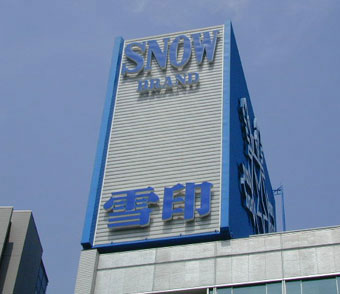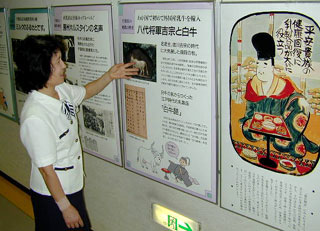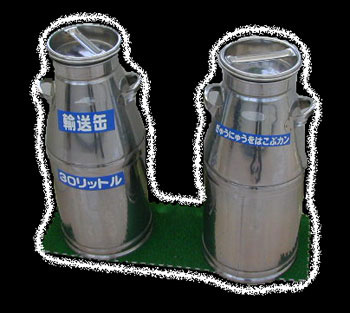Factory Tour: Snow Brand Milk
The elevator doors opened and I lumbered from the hall out onto the floor of the empty and quiet Newsroom. I moved between the cubicles toward my office with the swiftness of a running back and a recent convenience store purchase tucked under my left arm.
 Before reaching the end zone, a female voice boomed: "Where have you been for the last week!"
Before reaching the end zone, a female voice boomed: "Where have you been for the last week!"
She followed me into my office, her temper not far behind. "The Boss wants to know why you haven't been covering the nationwide milk contamination crisis! We have been scooped by every news agency across the nation!"
I hung up my coat and hat and settled back in my chair. "Well, you tell the Boss that I have been busy working on my story about the rash of recent crow attacks across the city, 'Maneaters of Meiji Jingu Park.' Catchy title, huh?"
"You spent a week in a park?" she asked while leaning over my desk.
"Well, rule number one in the news game, my dear, is that a top-notch reporter must cover his subject thoroughly."
She focused her glare on me. "You mean like your 6-week in-depth story on how to take advantage of the variation in pachinko ball surface friction coefficients?"
"I received nothing but positive feedback on that story. Sure, it may have been from 80-year old ladies and homeless men..."
Pretending I hadn't said anything, she continued, "The Snow Brand Milk Products factory in Osaka has been blamed for the poisoning of 13,000 people as a result of the contamination of its low-fat milk. Additionally, they may have tried to cover up the possible contamination of other products."
I grabbed a match from my pocket.
"Now, the Boss wants action," she added. "Since the Osaka factory has been shut down, I have arranged for you to tour the Snow factory in Chiba to find out what's going on."
Pulling an audible at this stage would be useless, I thought. A cigarette, though, might ease my oncoming headache - at least for a while.
It all began with an apology. Factory tours usually don't begin in such a way. But this was special, this was a poisoning.
 If its blue snowflake logo were real, it'd have melted weeks ago during the raging fire: Newspaper headlines announced executive resignations; the evening news programs demanded answers; and the company's reputation soured with each passing day.
If its blue snowflake logo were real, it'd have melted weeks ago during the raging fire: Newspaper headlines announced executive resignations; the evening news programs demanded answers; and the company's reputation soured with each passing day.
In late June, the scandal broke. Contaminated milk from Snow Brand Milk Products Co.'s Osaka plant resulted in the poisoning of more than 10,000 people in Western Japan. Improper cleaning methods, the reuse of unshipped products, and improper temperatures in tanks were found to be the reasons why harmful bacteria entered Snow's products.
Founded in 1925 as a dairy products cooperative, Snow, and its subsequently formed food division, has since established itself as Japan's premier dairy supplier. But times are now tough for Snow. Workers are confused, and its reputation is curdling. Could a factory tour help to sooth some frazzled nerves?
After issuing the apology, today's tour guide from the public relations department, Yuriko Yamano, quickly added, "Snow's Chiba factory adheres to only the highest health standards." On an upbeat note, she mentioned that Snow had also just released a new Snoopy milk tea product - paper box with smiling Snoopy in profile. Indeed, all was not lost.
The tour began in the presentation room with an introductory movie. A cow suit, complete with red suspenders, was hung on a hanger in the front right corner. Other than that the room, including its twenty-or-so chairs, was quiet.
 The trucking of the milk, homogenization, pasteurization, and packaging through the factory's 58,800-meter grounds is carefully documented and all to the accompaniment of a synth-based soundtrack.
The trucking of the milk, homogenization, pasteurization, and packaging through the factory's 58,800-meter grounds is carefully documented and all to the accompaniment of a synth-based soundtrack.
But the real tour begins outside on the catwalk that overlooks the factory grounds, a compound nestled amid a backdrop of freeway interchanges and car dealerships. With six 60-ton capacity steel tanks looming behind, this perch offers a view of the areas for truck arrival and departure, weighing, and inspection.
The silver-bodied trucks arriving from dairy farms are weighed both before and after milking. After the difference in weight is recorded by computer, the milk receives 12 different inspections. It is possible to receive 60 tons of milk, the equivalent of 300,000 small milk cartons, in one hour. With cooling equipment located beneath the tanks, the milk is then chilled to 3 degrees Celsius - the optimum temperature for milk storage.
The brains of the factory was the next stop.
The dairy processing begins with a selected amount of fat being scooped from the cooled milk. The remaining fat particles are then reduced to a uniform size of approximately 2.5 microns with the assistance of centrifuges, appropriately referred to as homogenization. From a viewing room the visitor is able to see the equipment necessary for this process along with that of the next step in the dairy operation, pasteurization.
The homogenized milk then enters a series of large corrugated steel plates, separated and sealed by gaskets. The milk is pressure fed through the top of the first plate and moves its way in a down-and-up pattern through the steel manifold maze. At the same time, boiling water enters from the bottom of the last plate and moves through the same maze of plates, though in the opposite direction, separated from the milk by the gaskets.
It is all about thermodynamics. The passage of water and milk allows for an exchange of heat to take place. A milk temperature of 120 degrees Celsius is reached (along with the deaths of many harmful bacteria). This pasteurized milk is then cooled in three 20-ton tanks or seven 10-ton tanks.
The electricity, steam, air pressure, and refrigerants used for the process are all monitored by what is called the "Energy Control System." In fact, the next process - the packaging of this now bug-free milk in an adjacent room - is also monitored by computer.
 Banks of computers resembling a low-budget sci-fi movie set overlook a room with hundreds of meters of conveyor belts that move small cartons of milk, low-fat milk, and yes, even Snoopy milk tea, in slot-car fashion from centrally located product dispensing machines. Blue crates and cardboard boxes wait patiently at the end of the trail. Even though delays can force the conveyors to sometimes resemble rush hour on a Los Angeles freeway, the factory can process 32,000 cases of 250 different types of drinks in one hour.
Banks of computers resembling a low-budget sci-fi movie set overlook a room with hundreds of meters of conveyor belts that move small cartons of milk, low-fat milk, and yes, even Snoopy milk tea, in slot-car fashion from centrally located product dispensing machines. Blue crates and cardboard boxes wait patiently at the end of the trail. Even though delays can force the conveyors to sometimes resemble rush hour on a Los Angeles freeway, the factory can process 32,000 cases of 250 different types of drinks in one hour.
At the conclusion of the tour, I thanked Yuriko and she, standing next to two 30-liter steel milk bottles, once again assured me of the high level of standards maintained at her factory. She also handed me a carton of Snoopy milk tea as a parting gift.
But was I completely convinced?
As I moved through the entrance gate, I plunged the straw into the carton with confidence. It was actually the grinning dog that did it.
Note: The Snow Brand Milk Products factory in Chiba, about a 15-minute walk from Umesato Station on the Tobu Noda Line. Tours are available by appointment at 0471-22-1116.

